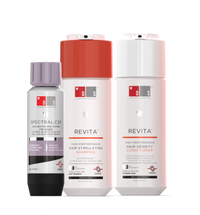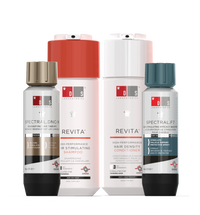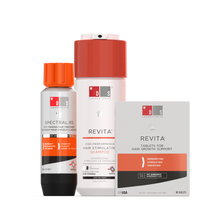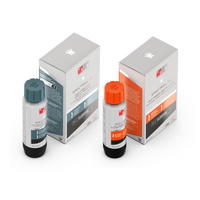A receding hairline is usually one of the first signs of male and female pattern baldness. Regardless of who experiences it, thinning hair is almost always a major cause for concern for many individuals, and many are willing to do anything (and spend any amount of money) to find a viable solution. Minoxidil — the main active ingredient in Rogaine® — is often the go-to answer for those who experience frontal baldness. However, studies suggest that the product, while effective at treating the vertex area, may not work so well along the hairline.
Does Minoxidil (Rogaine) Help With Frontal Baldness?
Translation missing: en.blogs.article.author_on_date_html
Minoxidil Is the Original Hair Loss Solution
First and foremost, it’s worth mentioning that minoxidil is a highly effective hair loss solution. First developed in the 1950s to treat ulcers, minoxidil has undergone extensive scientific studies, trials and research. Though ineffective for its original purpose, scientists noted an interesting side effect: It promoted hair growth. This led to the development of a topical solution for hair loss, which the FDA approved in 1988.
Since 1988, minoxidil continues to be the only FDA-recommended over-the-counter hair loss solution. It has a long history and hundreds of thousands of satisfied customers.
Minoxidil Is the Original Hair Loss Solution
First and foremost, it’s worth mentioning that minoxidil is a highly effective hair loss solution. First developed in the 1950s to treat ulcers, minoxidil has undergone extensive scientific studies, trials and research. Though ineffective for its original purpose, scientists noted an interesting side effect: It promoted hair growth. This led to the development of a topical solution for hair loss, which the FDA approved in 1988.
Since 1988, minoxidil continues to be the only FDA-recommended over-the-counter hair loss solution. It has a long history and hundreds of thousands of satisfied customers.
How Minoxidil Works
Minoxidil is a vasodilator. If this means nothing to you, don’t worry — you’re not alone. In layman’s terms, a vasodilator dilates the blood vessels and improves blood flow to certain areas of the body. When used in areas experiencing hair loss, minoxidil can open up the hair follicles and therefore allow more oxygen and nutrients to enter. This, in turn, promotes hair growth and health.
Minoxidil is not to be confused with finasteride, which works to reduce DHT in your blood stream. Minoxidil does not have any effect on your hormones, making it a completely localized solution. Moreover, the chemical promotes hair growth, while finasteride works to prevent hair loss.
How Nanoixidil Works
Nanoxidil differs ever-so-slightly from minoxidil. However, those variances make a world of difference when it comes to hair loss treatment.
The chemical makeup of nanoxidil is similar to that of minoxidil except that it has one less carbon chain. This divergence pushes nanoxidil into the class of agents called ion-channel openers. The role of such agents is to push open the ion channels within the cells themselves, rather than remaining a strictly surface solution. After pushing open the channels, the solution is then able to penetrate deeper into the cell and trigger cellular changes. Such changes, in this case, include removing or reducing the number of hair loss triggers.
The Difference That Matters
There is no denying that minoxidil works to help reverse hair loss. However, while minoxidil has been tested time again, researchers behind the product still haven’t been able resolve one of consumers’ biggest grievances: Frontal baldness. Nanoxidil solves that problem, which is likely due to its larger absorption capacity.
Spectral.DNC-N® and Revita® Vs. Rogaine®
Spectral.DNC-N® and Revita® are innovative new products for hair loss and some of Rogaine’s biggest competitors. Unlike Rogaine®, these new solution contain nanoxidil along with other active ingredients. For instance, the active ingredients in Spectral.DNC-N® are as follows:
- Retinol
- Azelaic acid
- Myristoyl pentapeptide-17
- Adenosine
- Copper peptide-1
- Caffeine
These ingredients all serve to improve scalp condition, aid in the healing process, regulate the expression of growth factors, inhibit DHT development, support the production of keratin and reverse the effects of DHT. What does this all mean for you? Increased hair growth, decreased hair loss and elimination of side effects.
One thing about Rogaine® that many people don’t talk about is its side effects. The side effects of this age-old solution go beyond the topical and can affect a person’s very health and well-being. Commonly reported side effects of minoxidil include temporary edema (swelling), scalp irritation, flushing, hypertrichosis (increased production of facial hair), drowsiness and dizziness. For many, the benefits of using minoxidil long-term do not outweigh the risks.
Nanoxidil — or, more specifically, Spectral.DNC-N® — comes with zero known side effects. Researchers attribute this, in large part, to the healing properties of many of its main active ingredients.
As for usability, nanoxidil-containing products are said to be easier to use than minoxidil-containing ones. Rogaine®, for instance, is greasy and causes scalp irritation. Spectral.DNC-N® is a water-based and non-greasy formula.
Recap
For much of the population, hair loss is inevitable. Everything from stress to lifestyle choices to genetics can all play a role in one’s hair health. However, thanks to advancements in science and technology, it is controllable. It is up to you to decide how you want to do that.
Rogaine® is a tried and true formula, but it comes with many adverse side effects, is not ideal for everyday use (you don’t want to show up to work with a greasy ‘do) and does not help with frontal baldness. Spectral.DNC-N® and Revita®, on the other hand, addresses minoxidil’s biggest drawbacks and presents a hair loss solution that works for the whole scalp, and not just the vertex. To see if a nanoxidil product is right for you, shop our collection of hair loss solutions today.

















